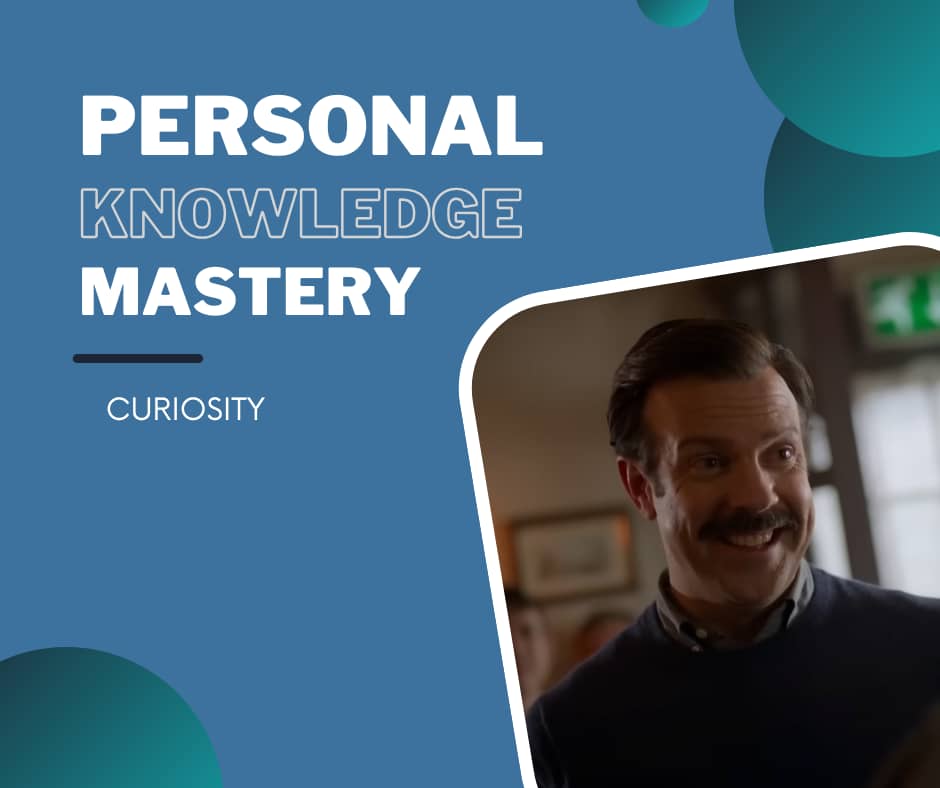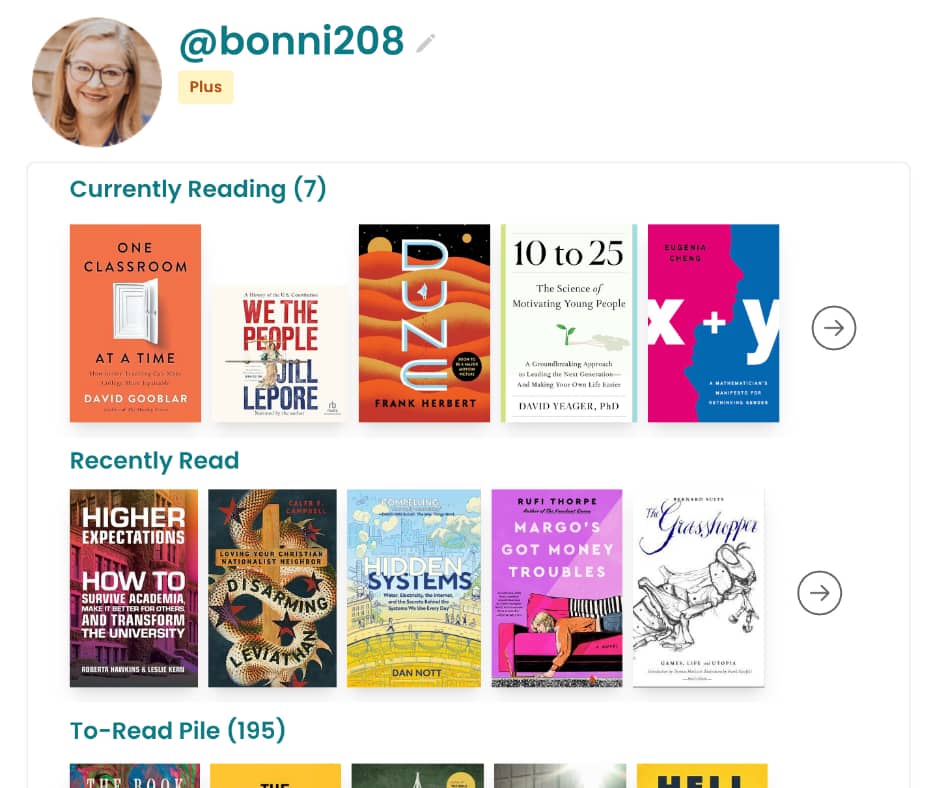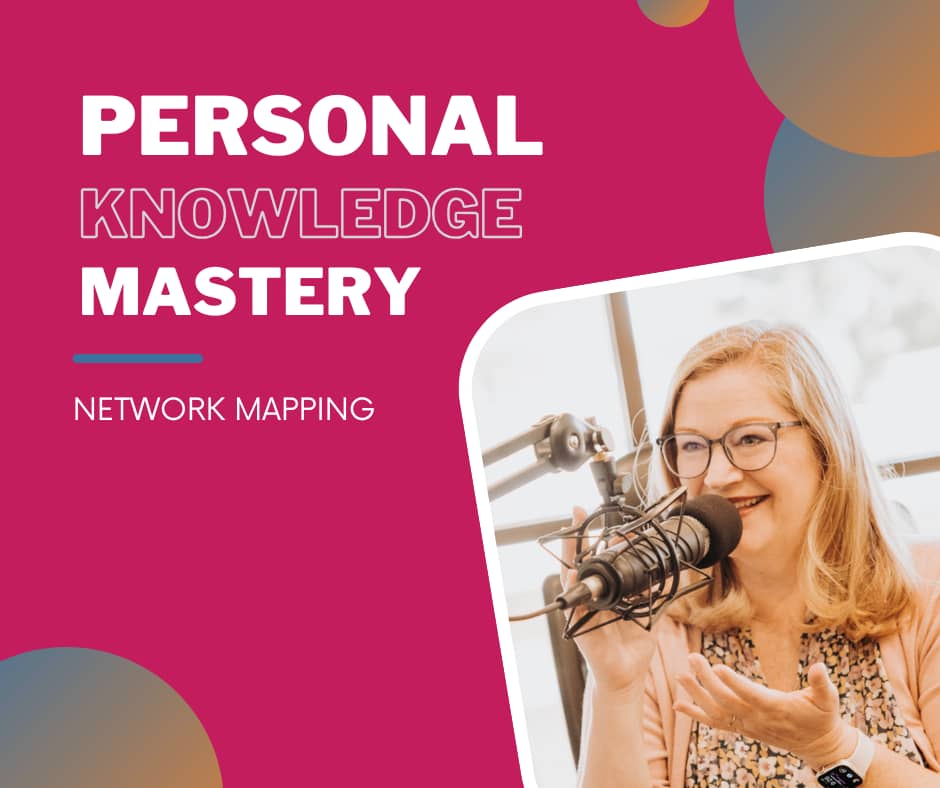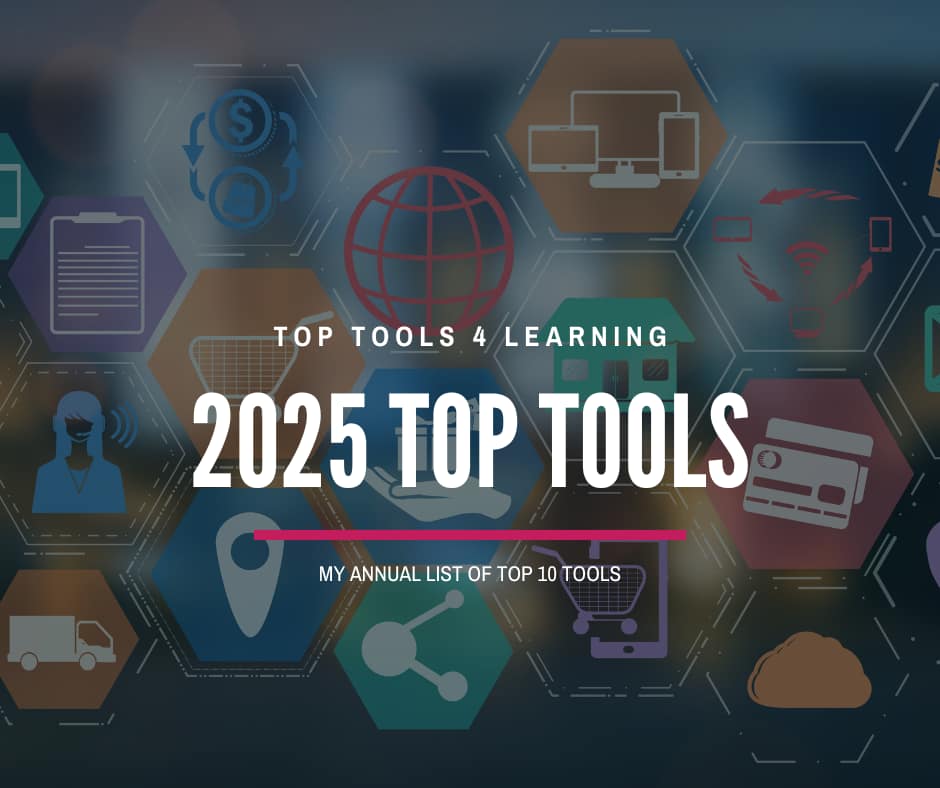Drat. I missed getting to officially contribute to the votes for this year’s Top 100 Tools for Learning, collected and analyzed by Jane Hart. I’m still going to write mine up, as I do like to reflect on the tools I’m relying on for my own and others’ learning, but I’ll need to wait until 2026 to get back into the mix of having my votes reflected in the grand total.
I used to be more regular with my votes, but did miss a few along the way. Here are my past Top 100 Tools for Learning: 2015, 2016, 2017, 2018, 2019, 2021, 2022, and 2024. I avoid looking at the prior year’s lists until I have identified my votes for current year.
This year, given that I missed the deadline for submitting my top ten list, I’m using a longer format than normal and structuring this reflection on Harold Jarche’s personal knowledge (PKM) framework, since so much of my learning is centered on it:
Seek > Sense > Share
Throughout all of my days, I’m plugged into intentional ways of seeking knowledge, wisdom, and sources of curiosity. In a way, sense-making is a part of my way of being, especially on those days when I allow myself to slow down enough for the deeper insights. Finally, I’m someone who delights in fueling my curiosity and imagination even further by sharing what I’m learning and inviting others to do the same.
Curious to learn more about personal knowledge mastery? My absolute favorite source for more than a decade now is Harold Jarche, who defines PKM as:
Personal knowledge mastery (PKM) is a set of processes, individually constructed, to help each of us make sense of our world and work more effectively. PKM keeps us afloat in a sea of information — guided by professional communities and buoyed by social networks. – Harold Jarche
Those who want to dig even deeper should consider joining Jarche’s Personal Knowledge Mastery cohort, starting in October 2025. Me: Going to look at my schedule and seeing if I’ve got the time to dive in at that time this year. Good stuff.
Seek
Seeking is finding things out and keeping up to date. Building a network of colleagues is helpful in this regard. It not only allows us to “pull” information, but also have it “pushed” to us by trusted sources. Good curators are valued members of knowledge networks. – Harold Jarche
Overcast
Not a day goes by that I don’t use Overcast, my preferred podcast catcher. On my iPhone, it is always my most used app on any given week.
Get ready to celebrate International Podcast Day on September 30. I’ve already got an episode queued up featuring Dominic Conroy & Warren Kidd to commemorate the event. Get your ears on and subscribe to Teaching in Higher Ed, if you haven’t already, using your favorite podcast app (search for Teaching in Higher Ed and hit subscribe/follow), YouTube, or Spotify.
While my backlog of episodes yet to be listened to is ridiculously long, Overcast’s playlists feature means I can tailor my audio consumption according to genre (news, technology, teaching, etc.), to my incoming priority/preferred podcasts, or to the queue list I have saved for the good stuff I want to get to when I have long drives or alone time.
Unread
While Overcast is for the spoken word, Unread is primarily for written pieces. Powered by real simple syndication (RSS), Unread presents me headlines of unread stories across all sorts of categories, which I can tap (on my iPad) to read, or scroll past to automatically mark as read. I use Unread in conjunction with Inoreader, which is a robust RSS aggregator that can either be used as an RSS reader, as well, or can be used in conjunction with an RSS reader, such as Unread. – From my 2024 Top 10 blog post (note: I only copied this text over after identifying what tools would be on this year’s list, as in I didn’t “cheat”).
One of the things I love about Unread is that I an perform the entire reading process with two thumbs (insert that joke/about “who has two thumbs and can…” and then add “operate Unread” at the end of it). I can browse the different folders/collections I have set up to skim headlines. When I want to read one of the stories associated with a given headline, I can go into it and read with just a tap. To get back out to the headlines, again, I just swipe right.
One big update that Unread 4.5 gave us is support for reading paywalled articles within the app. As of me writing this, I haven’t had a chance to experiment with that feature, but am excited to do so over this long, holiday weekend in the U.S. Anything I can do to reduce friction in my PKM system helps me be able to expand my possibilities for deeper learning.
YouTube
Once I found out that I could subscribe to new YouTube videos on my RSS reader, Inoreader, it changed how often I watch YouTube videos. That, plus subscribing to YouTube Premium, which means we get ad-free viewing as a family, makes me spending a lot more time with YouTube. I even have my own YouTube channel, which I occasionally post videos on. – From 2024 Top ten post
YouTube Premium continues to be a way of life for our entire family. If you watch a lot of YouTube and don’t have a means for watching ad-free, I can’t recommend it highly enough.
This past year, we added a Teaching in Higher Ed YouTube Channel. Each time an audio podcast episode gets posted on our hosting platform, Blubrry, it automatically gets shared on the channel. They used to not allow audio-only podcasts on the platform but made changes their rules such that now it is encouraged. In addition to listening to Teaching in Higher Ed, or watching an episode with Dr. Stephenie Cawthon accompanied by two ASL interpreters, you can also see other videos I’ve made this past year, such as:
Kindle App
I primarily read digitally and find the Kindle iPad app to be the easiest route for reading. I read more, in total, when I am disciplined about using the Kindle hardware, but wind up grabbing my iPad most nights. – 2024 Top 10 Post
Audible
New on the list for this year is Audible. I was attempting for a few months to better balance my daily news reading with sources that would give me a longer-term view of the world. As I write these words, I feel like I’m back to failing at this, but it was a good pursuit there for a while. Part of this attempt at balancing was made possible through listening to audio books in addition to podcast episodes.
Sometimes audio is better because it allows us to get more reading into our days. Other times, audio does something that the written word could never do. In the list below of some favorite audio boos from this past year, I’ll indicate with (best via audio book) at the end of the line if the audio book was particularly geared toward the audio medium.
- Braiding Sweetgrass, by Robin Wall Kimmerer
- Where the Deer and the Antelope Play, by Nick Offerman
- Hope in the Dark, by Rebecca Solnit
- The Wedding People, by Alison Espach (h/t Sarah Rose Cavanagh)
- Wild and Precious: A Celebration of Mary Oliver, by Mary Oliver, Sophia Bush, Ross Gay, Samin Nosrat, Rainn Wilson, and Susan Cain (best via audio book)
- How to Be Perfect: The Correct Answer to Every Moral Question, by Michael Shur (best via audio book) (h/t Betsy Barre)
Sense
Sensing is how we personalize information and use it. Sensing includes reflection and putting into practice what we have learned. Often it requires experimentation, as we learn best by doing. – Harold Jarche
StoryGraph
I decided to move off of Amazon’s Goodreads for my reading tracking this year and have been loving StoryGraph so far. I just wish more people were there to be friends with and share reading ideas. What I mostly use StoryGraph for is setting an annual reading goal and tracking my progress toward that. I also have quite a large queue of books I would like to read someday.
I understand that some people have a hard time finding something to read. This is not my problem. Trust me. I’ve got the what to possibly read thing down pat. But for those who are looking for suggestions, StoryGraph has that feature nailed, too. If anyone is on StoryGraph and wants to connect, my StoryGraph username is Bonni208 (as it is across most social networks that I’m on). Those curious about why the number 208 is significant to me, check out Teaching in Higher Ed Episode 208, where Dave helps me tell the 208 origin story.
Obsidian
Dave has been using Obsidian for years now and long-heralded the way that these types of note apps don’t lock you in, long-term. Using plain text (Markdown) documents that are stored where you want to keep them (not locked within the note service/subscription/app) means that Obsidian gets used as a way of viewing and adding to your plain text documents. That’s an oversimplification and one that meant I took longer than others to get to the party that is Obsidian.
One thing to know about Obsidian is that there is a learning curve. I would suggest not trying to go your own way on it, but instead to invest in some tools to help with your onboarding. I have three recommendations:
- The MacSparky Obsidian Field Guide – This course takes you through how to get started with Obsidian and set up systems to use this note-taking powerhouse to fuel your capacity for learning and teaching.
- Obsidian Starter Vault from Mike Schmitz – It can be hard starting from an entirely blank slate in Obsidian, so this starter vault can give you some content to work from and some tips for how to: “get more out of your notes and ideas effortlessly.”
- LifeHQ from Mike Schmitz – If you want to go even further with a system built by someone else, you can check out this extensive, customizable vault. I purchased it and over time have found ways to combine how Mike uses Obsidian to something that works better for me, most notably to incorporate my own custom version of Johnny Decimal (which I call Bonni Decimal; Let’s just say it has some emojis in the mix, in addition to the decimals/numbers, which I find quite satisfying) and doesn’t attempt to incorporate task management the way Mike has, instead relying on my beloved OmniFocus Pro.
ChatGPT
Ok. Here goes. I use artificial intelligence, despite knowing that there are plenty of ethical reasons that people may choose not to use AI. I encourage anyone thinking about shaming me or others who use it to read Maha Bali’s post suggesting that we not jump straight to that binary way of thinking about peoples’ use of these technologies. I don’t use it without continually refining my knowledge of what it is and isn’t capable of… but I do find that to be effective in my job, I am required to use it. Additionally, to enable us to cost-effectively offer transcripts for our podcasts and otherwise make our materials more accessible, AI is a must there, too.
I list ChatGPT here, since that is my most frequently-used AI tool, as it relates to learning. I pay for the $20/month paid service and occasionally find myself needing to use the separate pay-as-you-go API key for nichè use-cases. I asked ChatGPT to use what it knows about me to list off the ways that I use it in my learning (seeking, sensing, and sharing), and here is an edited version of it’s bulleted output:
- Seeking: exploring big questions about teaching, learning, and AI; summarizing complex articles or reports.
- Sensing: refining my “messy”/“chicken scratch” notes into themes, comparing frameworks, and generating questions that deepen reflection and conversation (with colleagues, students, or even my own family).
- Sharing: drafting polished communications – everything from faculty emails and strategic planning documents to podcast show notes and library fundraising blurbs.
- Iterating: co-creating interactive materials (like Twine games, PollEverywhere prompts, or Canva copy) where I can ask ChatGPT to generate multiple versions until it “clicks.”
- Blending Personal + Professional Contexts: whether it’s planning a weekly meal prep strategy, crafting conference questions, or designing playful activities for faculty, ChatGPT helps me weave learning into both my work and life.
It didn’t mention this, but I have been closely following Mike Caulfield‘s experimentation and research on what it can do using argumentation theory to come alongside us in our fact checking with his Deep Background GPT. There’s so much more I could say here, but I’ll save it for future posts.
Readwise
It is so easy to highlight sections of what I’m reading on the Kindle app and have those highlights sync over to a service called Readwise. The service “makes it easy to revisit and learn from your ebook and article highlights. – 2024 Top 10 post
I saw a video the other night which made mention of the ability to sync Readwise highlights with Obsidian (note taking tool) and that got me excited about that possibility. For now, I’ll be disciplined about placing that idea on my someday/maybe list and not going down the rabbit hole at this exact moment. Another thing on my someday/maybe list to look into more is Lance Eaton’s AI Practice: Building My Quote Collection.
Share
Sharing includes exchanging resources, ideas, and experiences with our networks as well as collaborating with our colleagues. – Harold Jarche
Raindrop
Much of my digital life revolves around digital bookmarking. I could have easily placed Raindrop in with sense making, as on an almost hourly basis, I find myself saving links and placing them in all the various collections (which are like folders) I have on Raindrop and applying tags. Whether I’m reading on my web browser, or via my smartphone or tablet, I can easily save bookmarks and have them accessible to me anytime in the future.
Just the other day, I was talking with a friend who is doing a lot of reflection and reading about loneliness and I asked if he had ever watched Andrea Dorfman’s How To Be Alone. He hadn’t and it was such a delight to be able to resurface that masterpiece and share it with him. I had an insight while watching it this time that since I have been spending more time working in our library lately that it seems like it may be the one place students feel more comfortable being alone than in other spots.
Another fun discovery, found within the deep crevasses of Raindrop was The Gap, by Ira Glass. “Your taste is good enough that you can tell that what you’re making is kind of a disappointment to you… Most everybody I know who does interesting, creative work, went through this phase for a few years…” Ira normalizes this gap of knowing what you’re doing could be better and being able to “fight your way through the gap.”
While most of my saved bookmarks (tags and collections) are private, I did decide recently to make an RSS feed and page with my saved links within an AI collection from Raindrop. This means that each time I save something related to AI on Raindrop, that anyone subscribed to that feed will have it show up in their RSS aggregator. Additionally, anyone who visits the page will see everything I’ve saved about AI within Raindrop. Candidly, as public as I am with the podcast and many other things, sharing this feed makes me a bit nervous, as I wouldn’t want people to think that I’m necessarily endorsing everything I’m saving. I’m pretty sure people would know that but given how polarizing the topic of AI can be, I still feel a bit nervous about this aspect of my sharing.
Your Turn
Would you like to submit a vote with your Top Tools for Learning? Unfortunately, you’re in the same boat as me and will need to wait until 2026. In the meantime, watch out for the 2025 Top Tools for Learning results to be posted by Monday, September 1, 2025.










